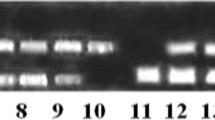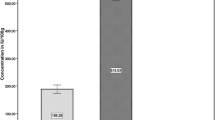Abstract
Objective
To evaluate the enzymatic and non-enzymatic antioxidants of leaf extract from Alpinia purpurata.
Methods
One gram of fresh leaf of Alpinia purpurata was grinded in 2 mL of 50% ethanol and centrifuged at 10,000×g at 4°C for 10 min. The supernatant obtained was used within 4 h for various enzymatic antioxidants assays like superoxide dismutase (SOD), catalase (CAT), glutathione peroxidase (GPx), glutathione S-transferase (GST), ascorbate oxidase, peroxidase, polyphenol oxidase (PPO) and non-enzymatic antioxidants such as vitamin C, total reduced glutathione (TRG) and lipid peroxidation (LPO).
Results
The leaf extract of Alpinia purpurata possess antioxidants like vitamin C 472.92±6.80 μg/mg protein, GST 372.11±5.70 μmol of 1-chloro 2,4 dinitrobenzene (CDNB)-reduced glutathione (GSH) conjugate formed/min/mg protein, GPx 281.69±6.43 μg of glutathione oxidized/min/mg protein, peroxidases 173.12±9.40 μmol/g tissue, TRG 75.27±3.55 μg/mg protein, SOD 58.03±2.11 U/mg protein, CAT 46.70±2.35 μmol of H2O2 consumed/min/mg protein in high amount whereas ascorbate oxidase 17.41±2.46 U/g tissue, LPO 2.71±0.14 nmol/L of malondialdehyde formed/min/mg protein and PPO 1.14±0.11 μmol/g tissue in moderate amount.
Conclusion
Alpinia purpurata has the potential to scavenge the free radicals and protect against oxidative stress causing diseases. In future, Alpinia purpurata may serve as a good pharmacotherapeutic agent.
Similar content being viewed by others
References
Grattagliano I, Bonfrate L, Diogo CV, Wang HH, Wang DQH, Portincasa P, et al. Biochemical mechanisms in drug-induced liver injury: certainties and doubts. World J Gastroenterol 2009;15:4865–4876.
Rani P, Meena UK, Karthikeyan J. Evaluation of antioxidant properties of berries. Ind J Clin Biochem 2004;19:103–110.
Shyamal S, Latha PG, Suja SR, Shine VJ, Anuja GI, Sini S, et al. Hepatoprotective effect of three herbal extracts on aflatoxin B1-intoxicated rat liver. Singapore Med J 2010;4:326–331.
Thaipong K, Boonprakob U, Crosby K, Cisneros-Zevallos L, Byrne DH. Comparison of ABTS, DPPH, FRAP, and ORAC assays for estimating antioxidant activity from guava fruits extracts. J Food Compos Anal 2006;19:669–675.
Sabu M. Zingiberaceae and Costaceae of South India. Indian Association for Angiosperm Taxonomy, Calicut University, India 2006;68–70.
Prajapathi ND, Purohit SS, Arun KS, Kumar T. A handbook of medicinal plants. A complete source book. New Delhi: Agrobios India 2004;35.
Victorio CP, Kuster RM, Lage CL. Detection of flavonoids in Alpinia purpurata (Vieill.) K. Schum. leaves using high performance liquid chromatography. Rev Bras Plant Med 2009;11:147–153.
Kochuthressia KP, John BS, Joelri ML, Jaseentha MO, Senthilkumar SR. Efficient regeneration of Alpinia purpurata (Vieill.) K.Schum. plantlets from rhizome bud explants. Int Res J Plant Sci 2010;1:43–47.
Oliver BV, Allan P, Macabeo G, Dietmar G, Karsten K, Scott GF, et al. Phytoconstituents from Alpinia purpurata and their in vitro inhibitory activity against Mycobacterium tuberculosis. Pharmacognosy Res 2009;1:435–439.
Das K, Samanta L, Chainy GBN. A modified spectrophotometric assay of superoxide dismutase using nitrite formation by superoxide radicals. Ind J Biochem Biophys 2000;37:201–204.
Sinha AK. Colorimetric assay of catalase. Anal Biochem 1972;47:389–394.
Rotruck JT, Pope AL, Ganther HE, Swanson AB, Hafeman DG, Hoekstra WG, et al. Selenium: biochemical role as a component of glutathione peroxidase. Science 1973;179:588–590.
Habig WH, Pabst MJ, Jakoby WB. Glutathione S-transferases: the first enzymatic step in mercapturic acid formation. J Biol Chem 1974;249:7130.
Addy SK, Goodman RN. Polyphenol oxidase and peroxidase in apple leaves inoculated with a virulent or an avirulent strain for Erwinia amylovora. Ind Phytopath 1972;25:575–579.
Vines HM, Oberbacher MF. Response of oxidation and phosphorylation in citrus mitochondria to arsenate. Nature 1965;206:319–320.
Sadasivam S, Manickam A, eds. Biochemical method. 2nd ed. New Delhi: New Age International (P) Limited;1996:108–110,185-186.
Boyne AF, Ellman GL. A methodology for analysis of tissue sulfhydryl components. Anal Biochem 1972;46:639–653.
Buege JA, Aust SD. Microsomal lipid peroxidation. Methods Enzymol 1978;52:302–305.
Yu Y, Du JR, Wang CY, Qian ZM. Protection against hydrogen peroxide induced injury by Z-ligustilide in PC12. Exp Brain Res 2008;184:307–312.
Du L, Yu Y, Li Z, Chen J, Liu Y, Xia Y, et al. Tim18, a component of the mitochondrial translocator, mediates yeast cell death induced by arsenic. Biochemistry 2007;72:843–847.
Marnett LJ. Oxyradicals and DNA damage. Carcinogenesis 2000;21:361–370.
Arulselvan P, Subramanian SP. Beneficial effects of Murraya koenigii leaves on antioxidant defense system and ultrastructural changes of pancreatic-cells in experimental diabetes in rats. Chem Biol Interact 2007;165:155–164.
Ali SS, Kasoju N, Luthra A, Singh A, Sharanabasava H, Sahu A, et al. Indian medicinal herbs as sources of antioxidants. Food Res Inter 2008;41:1–15.
Chandra R, Aneja R, Rewal C, Konduri R, Dass K, Agarwal S, et al. An opium alkaloidpapaverine ameliorates ethanol induced hepatotoxicity: diminution of oxidative stress. Ind J Clin Biochem 2000;15:155–60.
Krishna MS, Vishnu PV. Lipid peroxidation, glutathione, ascorbic acid, vitamin E, antioxidant enzyme and serum homocysteine status in patients with polycystic ovary syndrome. Biol Med 2009;1:44–49.
Chelikani P, Ramana T, Radhakrishnan TM. Catalase: a repertoire of unusual features. Ind J Clin Biochem 2005;20:131–135.
Nicolas Smirnoff. The functional metabolism of ascorbic acid in plants. Annals Bot 1996;78:661–669.
Hernandez Y, Lobo MG, Gonzalez M. Determination of vitamin C in tropical fruits: a comparative evaluation of methods. Food Chem 2006;96:654–664.
Pastore A, Federici G, Bertini E, Piemonte F. Analysis of glutathione: implication in redox and detoxification. Clin Chim Acta 2003;333:19–39.
Prabhakar PK, Doble M. Mechanism of action of natural products used in the treatment of diabetes mellitus. Chin J Integr Med 2011;17:563–574.
Author information
Authors and Affiliations
Corresponding author
Rights and permissions
About this article
Cite this article
Raj, C.A., Ragavendran, P., Sophia, D. et al. Evaluation of in vitro enzymatic and non-enzymatic antioxidant properites of leaf extract from Alpinia Purpurata (Vieill.) K. Schum.. Chin. J. Integr. Med. 22, 691–695 (2016). https://doi.org/10.1007/s11655-014-1762-1
Received:
Published:
Issue Date:
DOI: https://doi.org/10.1007/s11655-014-1762-1




